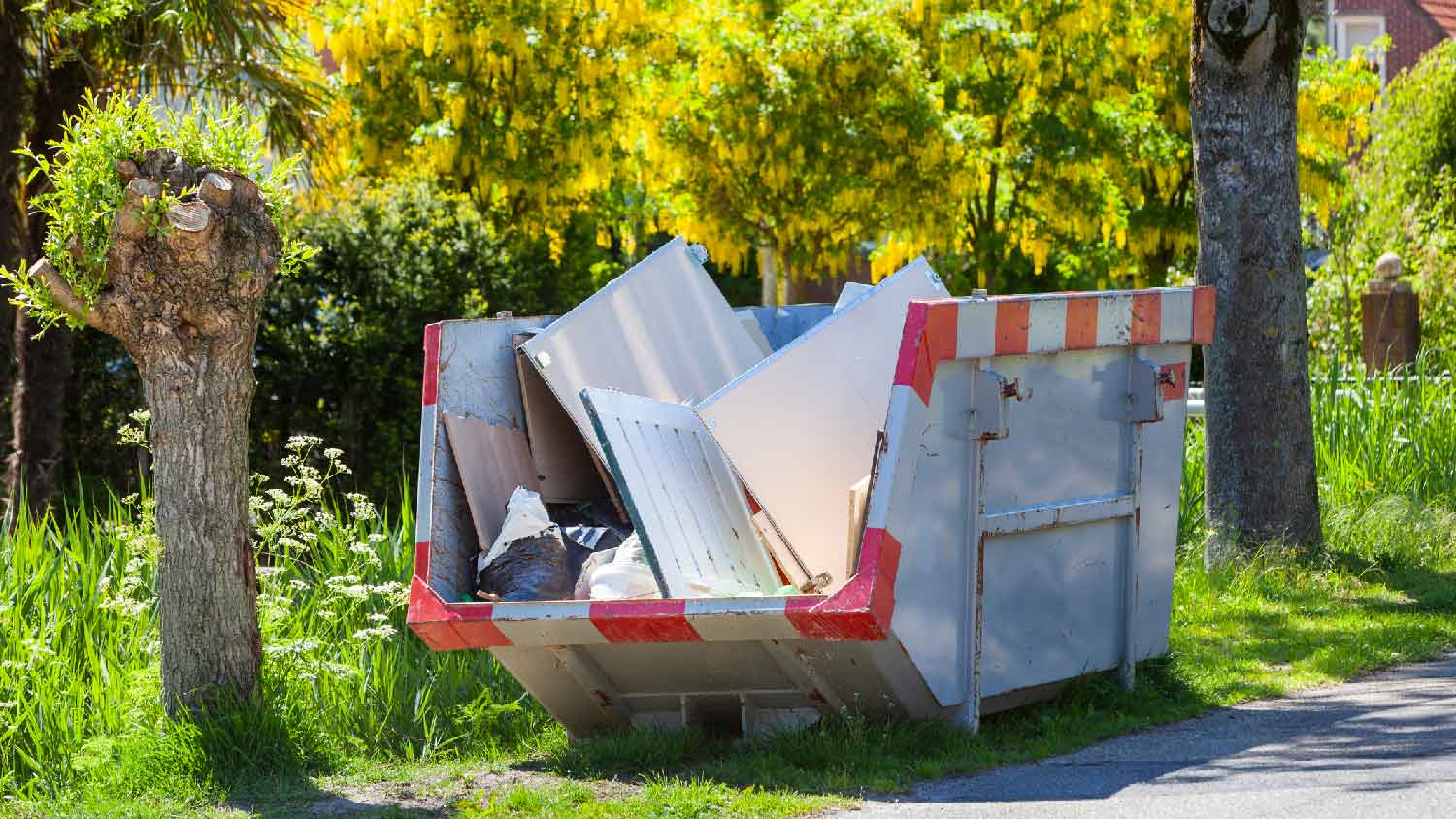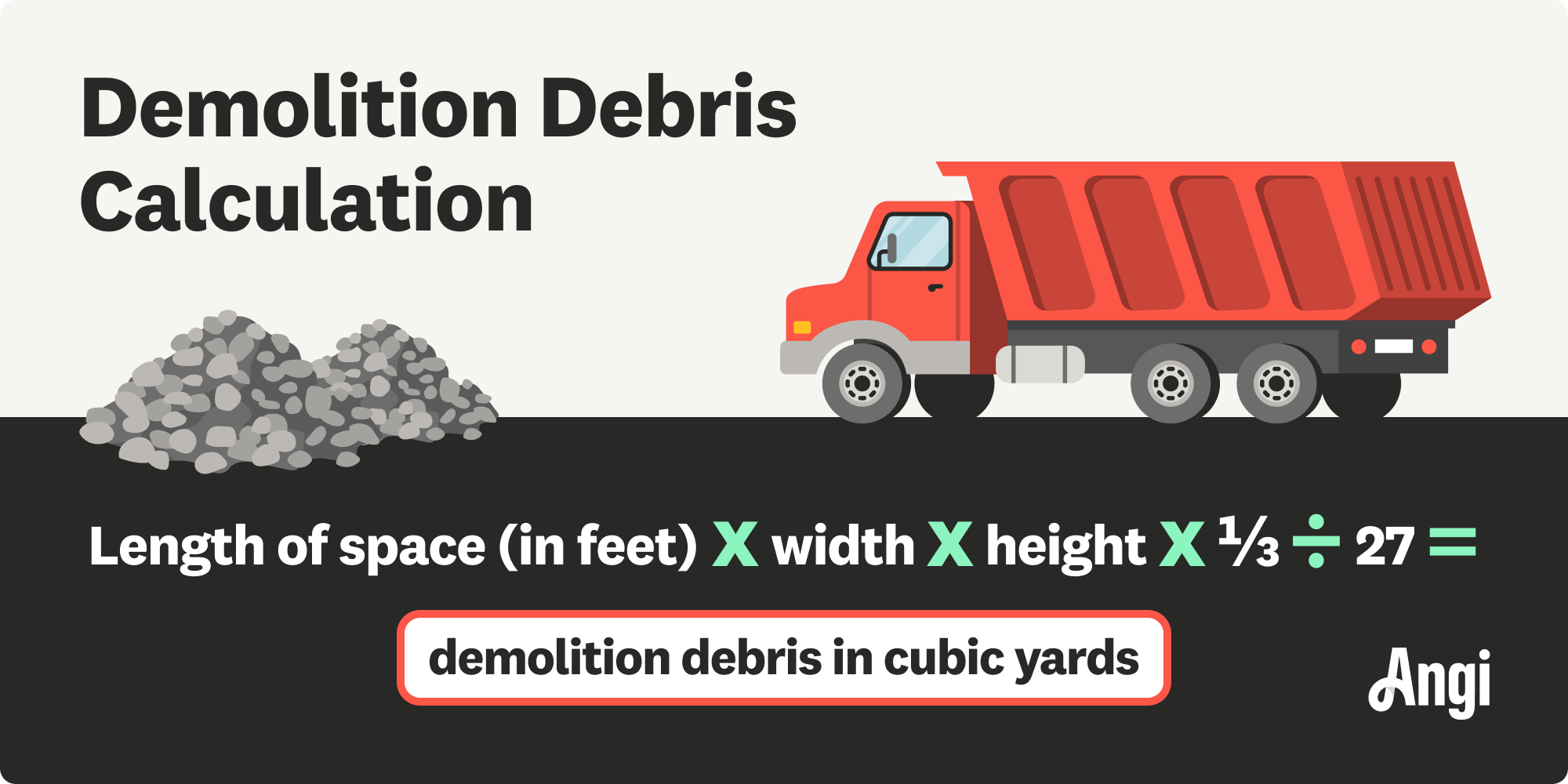
How much does it cost to demolish a house? Average prices for demolition vary based on home size, materials, and location. A partial demolition can make a project more affordable than a full house demolition. Keep reading for more.
Before coming in like a wrecking ball, estimate the debris first


The equation for demolition calculation is: length of space (in feet) x width x height x 1/3 ÷ 27 = demolition debris in cubic yards.
Expect to spend an average of $800 on a kitchen or bathroom demo and $15,800 on a whole-home demo, depending on the project’s specifications.
Hiring a demolition contractor can save you a lot of time in complex calculations and labor for large and dangerous demo jobs.
You’re finally tearing out that outdated kitchen and laying the groundwork for fresh granite counters, sleek cabinets, and beautifully tiled floors. But before you can build the kitchen of your dreams, you need to make space for something new. One important step of demolition is estimating the amount of debris you’ll produce so that you can rent the right-sized dumpster to hold it all. Learn how to calculate demolition in a few simple steps.
You (or the demolition pros you’ve hired) will need to calculate the anticipated waste from your demolition project in order to rent the proper number of dumpsters to haul away the demolition debris. You’ll need to haul the demolition waste away as soon as possible to finish the demolition and move forward with your home improvement project.

When learning how to calculate demolition waste, you’ll need to calculate for cubic yards. But you’ll also want to account for any airspace, or the empty spaces between walls, floors, and other materials that won’t turn into debris that needs to be hauled away.
That’s why it’s important to follow the 1/3 rule to account for this extra space. To calculate demolition waste, you’ll need to multiply the area of the space, measured in cubic feet, by ⅓ before dividing that total by 27 to get an accurate estimate of debris in cubic yards.
Here’s a basic equation to follow to estimate demolition debris:
Length of space (in feet) x width x height x 1/3 ÷ 27 = demolition debris in cubic yards
You may be wondering why you need to convert the total cubic feet into cubic yards. As it turns out, many dumpster rental companies measure the dumpster size by cubic yards to help succinctly measure the debris volume.
While dumpster rentals are measured by their cubic yard capacity, they also have weight limits. You’ll need to let the company know what waste materials you’ll be throwing out since materials like concrete and brick are heavier than materials like drywall and roof shingles. A small dumpster may have a weight limit of around 1,000 pounds, while bigger dumpsters may hold up to six tons of waste.

Let’s break down each part of the demolition waste calculation, starting with finding the area in square feet to calculating for airspace to converting the estimate into cubic yards.
Start by calculating the area of the space you plan to demolish. You can either check the blueprints of the house or grab a measuring tape and measure the length, width, and depth of the space. Jot down each measurement in feet and multiply the three measurements to determine the area in cubic feet.
Length (feet) x width (feet) x height (feet) = Area (cubic feet)
The room or area you’re planning to demolish isn’t just one solid block of materials. There are spaces in the room as well as spaces between drywall. To estimate a total without including airspace, you’ll need to multiply the area in cubic feet by 1/3.
Area (cubic feet) x 1/3 = Area (cubic feet) after accounting for airspace that will not become debris
If you need to rent a dumpster or truck to haul away the demolition debris, you’ll want to know how many cubic yards, not feet, of waste you expect to have. This will make it easier to calculate how much dumpster space you need, since cubic yards are the standard measurement for dumpster capacity.
Area (cubic feet) after accounting for airspace ÷ 27 = demolition debris (cubic yards)
Once you have an estimate of the cubic yards of waste that the demolition will produce, it’s time to calculate how many dumpsters you’ll need. Dumpsters come in standard sizes of 5, 10, 20, 30, and 40 cubic yards.
Demolition debris estimate (cubic yards) ÷ dumpster capacity in cubic yards = number of dumpsters (round up if you get a decimal)
For example, if you estimate 100 cubic yards of waste from a demolition, and you want to rent 20-cubic-yard dumpsters, you’d need five dumpsters.

The cost to rent a dumpster for demolition debris is $200 to $800 per week on average, and the cost to haul away junk is $60 to $700, depending on the amount of waste.
Demolition costs can vary widely based on the project. On average, you can expect to spend $4 to $20 per square foot, but here are some common costs based on the type of demolition.
Entire home demolition cost: $6,000–$25,500
Garage demolition cost: $2,000–$10,000
Kitchen demolition cost: $300–$3,000
Bathroom demolition cost: $300–$3,500
Concrete demolition cost: $600–$1,800
Pool demolition cost: $5,000–$8,000
Hiring a local demolition pro can help you get the most accurate demolition and dumpster rental cost estimates. Plus, the pros will make sure to pull the proper permits and demolish the site safely and efficiently so that you can get on to the more exciting part—starting your next home improvement project.
I had Ace Fireplace Services install custom chimney caps for my home, and the results are stunning. They fit like a glove and have added a touch of sophistication to my chimney. I can't recommend their services enough.
Custom Paint Jobs LLC turned our outdated bathroom into a modern masterpiece.
Very professional and efficient with work. Answered each question I had with great knowledge and an informative response. Will be working with them again.
Window Depot did an amazing job on my deck. I wasnt sure what I wanted to do, but their composite decking was affordable and will last a long time. I am excited to have family over, and I am no longer embarrassed by my backyard. Jeff and the ground crew were polite, respectful, and caring for...
Storms Mobile Welding was great to work with. They were prompt, professional and did an overall excellent job on the project. I highly recommend.
AFS was excellent from start to finish. Jess, the sales associate, was fantastic...very knowledgeable and very professional. The installation crew was excellent. I couldn't be more pleased with the process. Best of all, my new floor looks fantastic!
We used Unique Hardwood Floor LLC three years ago to work on the floors of a 70 year old home that needed a great deal of work. Some floors needed repairs, some were replaced and others just needed to be refinished. It was a complicated job as they needed to blend the old and the new to...
I play a yearly service fee to get my heat and AC checked out, twice a year. It's awesome. The techs are always great.
They do good work, were quick to respond, and their prices were as reasonable as plumbing work can be. They were fairly good with the sewer cleaning, and I have no complaints with their work, but I had to go beyond what they could do and get some excavation work done.
From average costs to expert advice, get all the answers you need to get your job done.

How much does it cost to demolish a house? Average prices for demolition vary based on home size, materials, and location. A partial demolition can make a project more affordable than a full house demolition. Keep reading for more.

The cost to re-level your mobile home depends on your home’s location, size, and whether it needs extra support. Read more about the cost of leveling your mobile home.

Time to get rid of that old chipped and crumbling walkway? Concrete removal costs can add up, but you have options to simplify the process. Learn more here.

Using a trencher is more efficient than using a shovel when excavating. Here’s a basic guide on how to use a trencher for your next project.

Excavation is any digging into the earth’s surface, and trenches are a deep, narrow type of excavation. Learn more about excavation versus trenches.

Trenches and ditches both involve excavation, but they serve different purposes. Unsure which one you need? Let’s compare a trench versus a ditch.